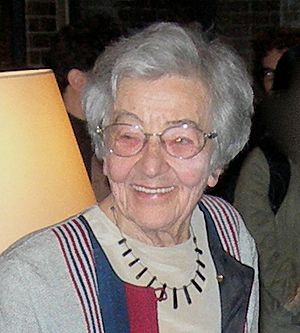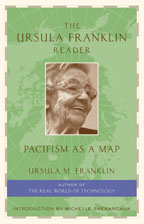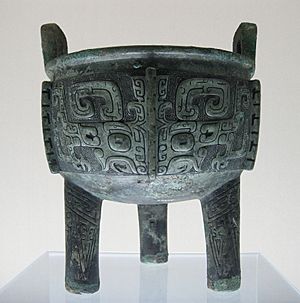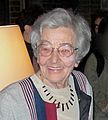Ursula Franklin facts for kids
Quick facts for kids
Ursula Franklin
CC OOnt FRSC
|
|
|---|---|

Franklin in 2006 during the launch of The Ursula Franklin Reader at Massey College in Toronto
|
|
| Born |
Ursula Maria Martius
16 September 1921 |
| Died | 22 July 2016 (aged 94) |
| Nationality | German-Canadian |
| Citizenship | Canadian |
| Alma mater | Technical University of Berlin University of Toronto |
| Known for | Archaeometry Pacifism Feminism Theories of technology |
| Spouse(s) |
Fred Franklin
(m. 1952) |
| Awards | Governor General's Award (1991) Pearson Medal of Peace (2001) |
| Scientific career | |
| Fields | Metallurgist, physicist |
| Institutions | University of Toronto |
| Influences | Jacques Ellul Lewis Mumford C. B. Macpherson E. F. Schumacher Vandana Shiva |
Ursula Martius Franklin (1921–2016) was a German-Canadian scientist, writer, and teacher. She taught at the University of Toronto for over 40 years. She was a metallurgist (someone who studies metals) and a physicist (someone who studies how the world works).
Ursula Franklin wrote several important books. These include The Real World of Technology and The Ursula Franklin Reader. She was also a Quaker, a religion known for its focus on peace. She worked hard for peace and women's rights. She believed that war was pointless and that peace was connected to social justice (fairness for everyone).
Franklin received many awards for her work. These include the Governor General's Award for helping women in Canada. She also received the Pearson Medal of Peace for her work in human rights. In 2012, she joined the Canadian Science and Engineering Hall of Fame. A high school in Toronto, Ursula Franklin Academy, is named after her.
Franklin is famous for her ideas about how technology affects society. She saw technology as more than just machines. For her, it was a whole system. This system includes methods, rules, and even a way of thinking. She talked about two types of technology: holistic and prescriptive. Holistic technology lets people control their own work. Prescriptive technology breaks work into small steps, often needing a boss to supervise. Franklin believed that prescriptive technologies make people less likely to think for themselves.
She was inspired by thinkers like Jacques Ellul and Lewis Mumford. These thinkers warned about technology taking away freedom. Franklin also felt that science was missing out because women were not encouraged to join.
Contents
Early Life and Education
Ursula Maria Martius was born in Munich, Germany, on September 16, 1921. Her mother, Ilse Maria Martius, was a Jewish art historian. Her father, Albrecht Martius, studied different cultures.
Because of the Nazis persecuting Jewish people, her parents tried to send her to school in Britain. But she was too young. Ursula studied chemistry and physics at Berlin University. The Nazis later expelled her. Her parents were sent to concentration camps. Ursula was sent to a forced labor camp to fix bombed buildings. Luckily, her family survived The Holocaust and met again in Berlin after the war.
A Career in Science
Franklin chose to study science because history was censored in schools at the time. She liked that the rules of physics and mathematics could not be changed by anyone in power. In 1948, she earned her Ph.D. in physics from the Technical University of Berlin. She wanted to leave Germany because she disagreed with its focus on military power.
In 1949, Franklin moved to Canada. She received a special fellowship at the University of Toronto. From 1952 to 1967, she worked as a research scientist. In 1967, she became a professor at the University of Toronto. She was an expert in metallurgy and materials science. She became a full professor in 1973. In 1984, she was the first woman to be named "University Professor." This is the highest honor a professor can receive at the university. She retired in 1987 but continued to be involved with the university.
Scientific Discoveries
Franklin was a leader in archaeometry. This field uses modern science to study old artifacts. For example, she helped date ancient bronze, copper, and ceramic items. She also studied shiny black Chinese mirrors found in old tombs. She found that the dark color was added on purpose, not from rust. Her work also helped date ancient glass beads used in trade between Native American tribes and Europeans.
In the 1960s, Franklin joined the Baby Tooth Survey. This project studied levels of strontium-90 in children's teeth. Strontium-90 is a radioactive substance from nuclear weapons testing. This research helped stop above-ground nuclear tests. Franklin wrote over a hundred scientific papers. These papers were about metals and the social effects of technology.
In the 1970s, Franklin was part of the Science Council of Canada. She led a study on saving resources and protecting nature. Their 1977 report, Canada as a Conserver Society, suggested ways to reduce waste. This work helped shape her ideas about modern technology.
Working for Change
Franklin was also very active in the Voice of Women (VOW), now called the Canadian Voice of Women for Peace. This group works for social change in Canada. In 1968, she and another leader, Muriel Duckworth, spoke to the Canadian Parliament. They said that Canada and the U.S. had made military trade deals without enough public discussion. They argued this made it hard for Canada to have its own foreign policy.
In 1969, Franklin and Duckworth asked the Canadian Senate to stop chemical and biological weapons research. They wanted the money spent on environmental research and health care instead. Franklin also urged the government to leave NATO and work on disarmament (reducing weapons).
In the 1980s, Franklin supported people who refused to pay taxes for military uses. She argued that people should be able to direct their taxes to peaceful purposes. She believed this was part of the freedom of conscience.
After she retired, Franklin and other female professors sued the University of Toronto. They claimed the university paid women less than men. In 2002, the university agreed that many women professors had faced unfair pay. About 60 retired women received money to make up for lower salaries and pensions.
Franklin continued to encourage young women to study science. She also kept promoting peace and social justice. Many of her writings and speeches are in The Ursula Franklin Reader.
Peace, Fairness, and War
Ursula Franklin explained that her life's work was about understanding "structures." She wanted to know how things are put together. She asked: "How can one live as a pacifist and help create a society where violence decreases and fairness increases?"
She used the idea of maps to explain her journey. She felt that old maps, showing "us" versus "them" or winning and losing, were not helpful. She said she was guided by "the maps of pacifism and feminism."
For Franklin, feminism was a new way of seeing the world. She said: "Feminism isn't an employment agency for women; it's an alternative way of ordering the social space." It focuses on working together, not competing. She felt joy in seeing the world differently through feminism.
Peace and Conscience
A key part of Franklin's beliefs was the "Quaker vision of the world." This vision puts individual conscience first. Quakers have opposed war for over 300 years. They have worked for peace and disarmament.
Franklin noted that technology has changed war. There is no clear line between war and peace anymore. War planning happens all the time. When wars are fought, women and children are often targets. Modern wars rely on expensive weapons, not just soldiers. Franklin said that this "technological imperative" needs an enemy. This means governments create an enemy to justify spending money on weapons.
She pointed out that people are forced to pay for war preparations through taxes. This can go against their personal beliefs.
Peace and Social Justice
In her 1987 paper, Reflections on Theology and Peace, Ursula Franklin said: "Peace is not the absence of war—peace is the absence of fear." She meant fear from war, but also from not having enough money, a job, or a home. Franklin called this a "threat system" that controls people by making them afraid.
|
"Peace is not the absence of war—peace is the absence of fear." |
| – Ursula Franklin in The Ursula Franklin Reader. |
For Franklin, social justice is needed to remove fear and bring peace. Justice means freedom from unfair treatment and equality for everyone. She believed that in societies focused on buying things, war and violence are likely. She quoted historian Lewis Mumford, who said that greed became a good thing during the rise of capitalism. Franklin argued that this focus on money leads to problems like militarized economies and closed borders for refugees. She warned about "techno-fascism," a global system of control that works against people and fairness.
Globalization as a New Kind of War
Franklin believed that after the Cold War, the world changed. Instead of big wars between superpowers, there were smaller regional wars. Also, war changed into a struggle for global economic power. She called this new form of war "globalization." Its battlefields are stock markets and currency markets.
This economic war sees anyone who cares about community values as an enemy. Things that cannot be bought or sold are seen as obstacles. A main strategy is to sell off public services like healthcare and education for private profit. Franklin said that these "marketeers" turn people's problems into ways to make money. She felt they act like "occupying forces" with "puppet governments."
Franklin suggested ways to resist. She said people should refuse to use the language of these "occupiers." This means not calling teachers "consumers of education" or patients "health-care providers." She also suggested using courts and electronic media to share information. Finally, she supported "citizen politics." This is when people work together to solve common problems, from peace to homelessness. She encouraged "scrupling," which means discussing moral concerns together. Citizen politics tries to improve governments and protect communities from those who want to turn the world into one big resource for profit.
War: A Failed Solution
Ursula Franklin often said that war and violence are not only wrong but also useless and costly. After the September 11 attacks in the U.S., she said that violence never truly solves anything. "Nothing has been resolved by violence over the past fifty years," she stated.
|
War does not work, not even for the warriors. |
| – Ursula Franklin on the first anniversary of the 11 September attacks. |
She wrote that "violence begets more violence, war begets further wars, more enemies and more suffering." Franklin thought the U.S. should have seen the 9/11 attacks as a political earthquake, not an act of war. She believed that social problems, like geological ones, can be understood and lessened, but not stopped by bombing.
Franklin argued that military systems are the extreme form of unfair social structures. They assume some people matter less than others. She noted that many women's rights leaders, like Jane Addams, were also pacifists. For her, fighting for women's rights and opposing militarism were two sides of the same coin.
Understanding Technology
For Ursula Franklin, technology is more than just machines. It's a way of doing things in the "here and now." It's a complete system that includes how things are organized, procedures, and even a way of thinking. She believed technology has shaped our world. "Technology has built the house in which we all live," she wrote. Her studies aimed to understand how technology affects justice and peace.
Holistic and Prescriptive Technologies
Franklin believed that different types of technology have different social effects. She separated technologies into "work-related" and "control-related." Work-related technologies, like a typewriter, make tasks easier. But when computers are linked in a system, they become control-related. This allows bosses to time workers and monitor their actions.
She expanded this idea to "holistic" and "prescriptive" technologies. Holistic technologies are often used by craftspeople. An artisan, like a potter, controls their work from start to finish. Each item they make is unique. Prescriptive technologies, however, break work into many small, standard steps. Each worker only does one small part.
This idea of breaking down work is often linked to the Industrial Revolution. But Franklin pointed out that it has been used since ancient times. For example, ancient Chinese bronze casting needed strict control and a clear division of labor. Franklin realized that these prescriptive technologies were not just about making things. They were also about discipline, planning, and control.
Technology and Compliance
Franklin argued that in modern society, control-related and prescriptive technologies are most common. When work is broken into steps, the control moves to the boss. She called prescriptive technologies "designs for compliance." This means they make people used to being controlled and following rules. People start to believe there's only one way to do things.
While these technologies can be very efficient, Franklin said they come with a "social mortgage." This means we live in a "culture of compliance." We are taught to accept rules and believe there's only one right way.
Prescriptive technologies have spread beyond factories. They are now used in government and social services. Franklin believed that tasks like caring for people, in health or education, are best done holistically. But these tasks are increasingly treated like factory production. For example, schools test students based on strict schedules. Franklin said that education is a holistic process that cannot be broken into rigid steps.
Technology and Power
Ursula Franklin did not believe that powerful technologies automatically decide how people live. She said that how we use technology is a choice. She felt that dominant prescriptive technologies create power structures that are often male-dominated. These structures are about hierarchy, control, competition, and exclusion. Women workers often suffer from these patterns.
For example, sewing machines were supposed to free women from housework. But they ended up in factories, creating cheap clothing in sweatshops. This new technology was used to exploit female workers. Franklin noted similar examples in other industries. Women telephone operators were replaced by automated systems. Secretaries did fragmented, meaningless tasks with new typewriters.
Franklin wrote that "Many technological systems... are basically anti-people." She felt that people are seen as problems, and technology as the solution. This means people live and work in ways that benefit technology, even if it's presented as "liberating." She argued that work could be less rigid if we used more holistic practices. These practices could be based on how women traditionally manage households or care for children.
Communication Technologies
Franklin believed that powerful communication technologies have changed society. They make people feel distant from each other and their surroundings. Radio and television send instant messages from far away. These messages are separate from people's real-life experiences. Franklin called these messages "pseudorealities." They are built from images chosen to create emotions and the feeling of "being there."
She argued that one-way communication reduces "reciprocity." This is the normal give-and-take of talking face-to-face. News stories, she said, focus on the unusual to grab attention. Even if people can choose not to watch, these "pseudorealities" still shape the world. Franklin wondered why people seemed to give away their right to control their mental environment without consent.
The Importance of Silence
Franklin wrote that "Silence... possesses striking similarities [to] aspects of life and community, such as unpolluted water, air, or soil." She meant that silence, like clean air, was once normal but is now rare because of technology. She compared the constant background noise, like elevator music, to the "enclosure laws" that took common land for private use.
For Franklin, the power of silence is its openness to unexpected things. Quakers, for example, worship in collective silence. She said that in a Quaker meeting, someone might speak about something that was just on your mind. She believed this "collective silence" is a powerful spiritual force. Franklin encouraged people to protect the right to public silence. This could mean asking for music-free elevators or quiet rooms in public buildings. She also suggested starting meetings with a few minutes of silence.
Personal Life
In 1952, Ursula Franklin married Fred Franklin. He was an engineer of German Jewish background. He had learned about Quakerism in England, where he went to school to escape the Nazis. They had no family in Canada. After their two children were born, they joined the Society of Friends (Quakers) in 1964. Franklin said they were pacifists before becoming Quakers. She felt it was an easy change and that Quakerism became a good home and extended family for them. Ursula Franklin spent her last years in a nursing home with Fred, who outlived her. She passed away on July 22, 2016, at 94 years old.
Her Legacy
In April 2013, Franklin gave her large collection of writings on Chinese culture and history to the Confucius Institute at Seneca College in Toronto. This collection included over 220 books and papers. It also had some of her own working notes.
Franklin also donated her personal records to the University of Toronto. This collection includes letters with colleagues, family, and friends. It also has over 575 pages of surveillance on Franklin by the Royal Canadian Mounted Police. She gave her feminist and women's studies books to the UTM library.
Awards and Recognitions
Ursula Franklin received many awards. In 1984, she was the first woman at the University of Toronto to be named "University Professor." This is the highest honor given by the university. She was made an Officer of the Order of Canada in 1981 and a Companion in 1992. She also joined the Order of Ontario in 1990.
In 1982, she received an award from the City of Toronto for her work in neighborhood planning. She received the Elsie Gregory McGill memorial award in 1987 for her contributions to education, science, and technology. In 1989, she received the Wiegand Award for her work on how science and technology affect people.
In 1991, she received a Governor General's Award for promoting equality for girls and women in Canada. The same year, she received the Sir John William Dawson Medal. She received the 2001 Pearson Medal of Peace for her work in human rights. A Toronto high school, Ursula Franklin Academy, is named after her.
In 2004, Franklin received one of Massey College's first Adrienne Clarkson Laureateships for public service. She was inducted into the Canadian Science and Engineering Hall of Fame in 2012. She also received honorary degrees from many Canadian universities.
In March 2020, a street in Toronto, Russell Street, was renamed Ursula Franklin Street.
Images for kids
See Also
 In Spanish: Ursula Franklin para niños
In Spanish: Ursula Franklin para niños










